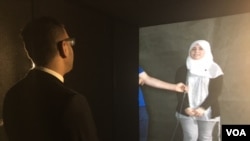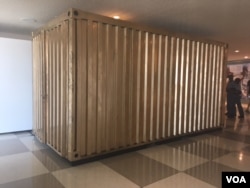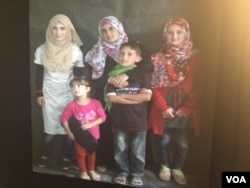"Hello, how are you?" came the slightly distorted voice of a 17-year-old girl wearing a white headscarf and gray jeans. Her name is Zab, and she lives among more than 79,000 other displaced Syrians at Zaatari refugee camp in northern Jordan.
She spoke very good English to Mohannad Jaber, who was standing inside a transformed shipping container on the other side of the world — in the lobby of the United Nations in New York.
Mohannad could see her image projected on a wall of the container, which has been sound-proofed and fitted with Skype-like audio-visual equipment and its exterior painted a shiny gold.
"Speak in Arabic," he urged her.
They chatted back and forth for about 10 minutes. Mohannad, who works for United Muslim Relief, an NGO, asked Zad about life in the camp. She said it was very, very hot there and electricity was scarce, so they cannot run their fan.
But small talk quickly became deeper. Zad appealed for better educational opportunities for refugee youth — especially to go to university — and expressed concern about early marriages.
"She said many families are pushing their sons and daughters to marry because of a lack of money," Mohannad said.
A growing rate of early or forced marriage has been one of the consequences of the Syrian civil war, which is now in its sixth year and has turned 5 million people into refugees, while displacing another 6.6 million inside the country. Jordan, Lebanon and Turkey host most of those who have fled.
Collapsing distances
Connecting refugees and New Yorkers was the brainchild of Amar Chopra Bakshi and Michelle Moghtader of Shared Studios, an art, design and technology initiative. They collaborated with UNICEF Jordan to create a portal at Zaatari.
"Our idea was to physicalize the internet," Moghtader said. "Our goal is to collapse distances — very real geographic ones and more imagined ones."
Part of the project's inspiration came from Bakshi's travels after the Sept. 11, 2001, attacks. Working for a U.S. newspaper, he traveled the Middle East and asked people why they disliked America, according to his mother, Gita Chopra Bakshi.
"He would be sitting in buses and talking to people … and he said the conversation we had there was so different than the conversations we would have here," she said, adding that he wanted to re-create that environment.
Bakshi and Moghtader began with one portal over a year ago, connecting people in New York and Tehran. They have since placed portals in 20 cities, from Kabul to Kigali to Havana.
Making it ‘real’
Back in the U.N. lobby, Richard Amdur, the U.N. Secretary-General's Director of Communications, stepped inside the golden shipping container. He talked via an interpreter with Akram, 12, who said he enjoys playing with his friends but also expressed worries about his father's lack of employment and their family's failed attempt to immigrate to another country.
"The country we wanted to go to denied us immigration status," Akram said. Heavy thoughts for a 12-year-old.
A refugee family chatted cheerfully about Ramadan with two young Iraqi women in New York. The family's youngest child, five-year-old Farrah — wearing a pink top and colorful hair clips — kept grabbing the microphone from her three siblings and mother to enjoy the novelty of talking to the far-away women.
The family fled Daraa, Syria, four years ago. It is the same city where the first protests began against the regime of President Bashar al-Assad after a group of teenage boys was arrested for anti-government graffiti.
For co-creator Bakshi's mother, Gita, the experience helps make real what she has read about the Syrian crisis.
"We can read about it forever, but that doesn't quite tell you what it is to be there. And of course we are not there, but this is probably the closest we can come to be able to see what their daily lives are like," she said.











